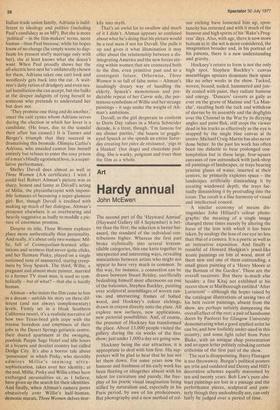Art
Hardy annual
John McEwen
The second part of fhe 'Hayward Annual' (Hayward Gallery till 4 September) is better than the first: the selection is better balanced, the standard of the individual contributions higher. Whereas the first part broke stylistically into several irreconcilable categories, this one knits together in unexpected and interesting ways, revealing associations between artists who might not appear to have very much in common. In this way, for instance, a connection can be drawn between Stuart Brisley, sacrificially bedaubing himself most afternoons on one of the balconies, Stephen Buckley, painting over sculptural assemblages of woven canvas and intersecting frames of bolted wood, and Hockney's colour etchings, drawn in crayon directly onto the plate. All explore new surfaces, new applications, new pictorial possibilities. And, of course, the presence of Hockney has transformed the place. About 13,000 people visited the gallery during the six weeks of the first show; just under 1,000 a day are going now.
Hockney being the star attraction, it is appropriate to deal with him first. His supporters will be glad to hear that he has not let them down. For some years now the humour and freshness of his early work has been fleeting or altogether absent with his talent for caricature and parody, the freeplay of his poetic visual imagination being stifled by naturalism and, especially in his Paris period, by awe of his predecessors. But photography and a new method of col
our etching have loosened him up, spontaneity has returned and with it much of the humour and high spirits of his 'Rake's Progress' days. Also, with age, there is now more bottom to it: the wit is more considered, the imagination broader and, in his portrait of his parents, there is a new understanding and gravity.
Hockney's return to form is not the only high spot. Stephen Buckley's canvas assemblages upstairs dominate their space like no other works in the show. Tacked, woven, bound, nailed, hammered and juicily coated with paint, they radiate humour and energy. 'Dancers' cavorts as gaily as ever on the grave of Matisse and `La Manche', recalling both the tuck and withdraw of sleeves by its assembly and the dogfights over the Channel in the War by its dizzying angles and paint flak, still stops the viewer dead in his tracks as effectively as the eye is stopped by the single blue canvas at its centre. Michael Craig-Martin has also never done better. In the past his work has often been too didactic to bear prolonged contemplation but in these large, four-square canvases of raw cottonduck with junk-shop oil paintings of landscapes, or trays bearing pristine glases of water, inserted at their centres, he primarily explores space — the landscapes artificiallydiminishing it by creating windowed depth, the trays factually diminishing it by protruding into the room. The result is a fine harmony of visual and intellectual conceit.
A similar economy of means distinguishes John Hilliard's colour photographs: the meaning of a single image changed three times merely by altering the focus of the lens With which it has been taken, by analogy the lens of our eye 'no less than that of a camera. It is a poetic as well as an instructive exposition. And finally a roomful of Howard Hodgkin's jewel-like iconic paintings on bits of wood, most of them new and one of them outstanding, a small green painting of a 'Henry Moore at the Bottom of the Garden'. These are the overall successes. But there is.much else besides: a fine Kitaj not exhibited at his recent show at Marlborough entitled 'After , Lorinzetti' — although the hopes raised by the catalogue illustrations of seeing two of his best recent paintings, absent from the show, are perhaps unfairly dampening the overall effect of the rest; a pair of handsome doors by Paolozzi fox Glasgow University 'demonstrating what.a good applied artist he can be, and how foolishly under-Used in this country; and some light relief from Peter Blake, with an antique shop presentation and an open letter politely rebuking certain criticisms of the first part of the show.
The rest is disappointing. Barry Flanagan is too throwaway. Burgin's political posters are trite and outdated and Denny and Hill's decorative schemes equally marooned by ten and twenty years. Bob Law's pure abstract paintings are lost in a passage and the performance pieces, sculptural and painterly though they undoubtedly are, can only fairly be judged over a period of time.


































 Previous page
Previous page